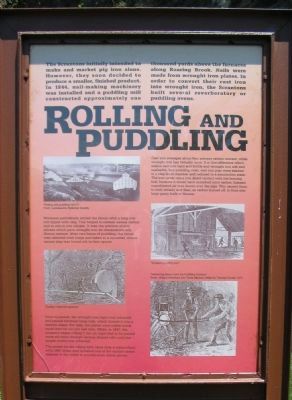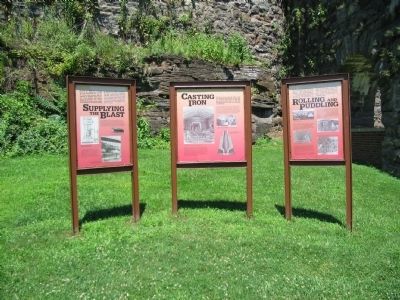Scranton in Lackawanna County, Pennsylvania — The American Northeast (Mid-Atlantic)
Rolling and Puddling
Cast iron averages about four percent carbon content, while wrought iron has virtually none. It is the difference which makes cast iron hard and brittle and wrought iron soft and malleable. In a puddling oven, cast iron pigs were stacked in a slag-lined chamber and reduced to a semimolten state. The iron never came into direct contact with the burning fuel, because it would have absorbed more carbon. Instead, superheated air was drawn over the pigs. This caused them to belt initially and then, as carbon burned off, to form into large pasty balls or blooms.
Workmen periodically stirred the bloom with a long iron rod tipped with slag. This helped to release excess carbon and to mix in the iron silicate. It was the addition of iron silicate which gave wrought iron its characteristically fibrous texture. After two hours of puddling, the bloom was removed with tongs and taken to a squeezer, where excess slag was forced out in fiery spurts.
Once squeezed, the wrought iron ingot was reheated and passed between large rolls, which formed it into a desired shape. For nails, flat plates were rolled which could later be cut into nail rods. When in 1847, the company began rolling T rail, an ingot had to be passed some six times through various shaped rolls until the proper profile was achieved.
The power for the rolling mills came from a waterwheel, until 1847 when they installed one of the earliest steam engines in the valley to provide more stable power.
Topics. This historical marker is listed in this topic list: Industry & Commerce. A significant historical year for this entry is 1844.
Location. 41° 24.237′ N, 75° 39.772′ W. Marker is in Scranton, Pennsylvania, in Lackawanna County. Marker can be reached from the intersection of Cedar Avenue and Mattes Avenue, on the right when traveling north. Located at the Scranton's Iron Furnace Park. Touch for map. Marker is in this post office area: Scranton PA 18505, United States of America. Touch for directions.
Other nearby markers. At least 8 other markers are within walking distance of this marker. Casting Iron (here, next to this marker); Supplying the Blast (here, next to this marker); Making Steel (a few steps from this marker); Settlement (a few steps from this marker); The Lackawanna Valley (a few steps from this marker); Scranton Iron Furnaces (within shouting distance of this marker); City of Scranton (within shouting distance of this marker); The Blast Furnaces (within shouting distance of this marker). Touch for a list and map of all markers in Scranton.
More about this marker. In the upper left is a photo of Rolling and puddling mill #1. Lower on the marker are three illustrations showing Workers puddling iron, then Removing bloom from the Puddling Furnace, and finally Cutting T-Rail into sections.
Credits. This page was last revised on June 16, 2016. It was originally submitted on August 21, 2008, by Craig Swain of Leesburg, Virginia. This page has been viewed 1,554 times since then and 17 times this year. Photos: 1, 2. submitted on August 21, 2008, by Craig Swain of Leesburg, Virginia.

